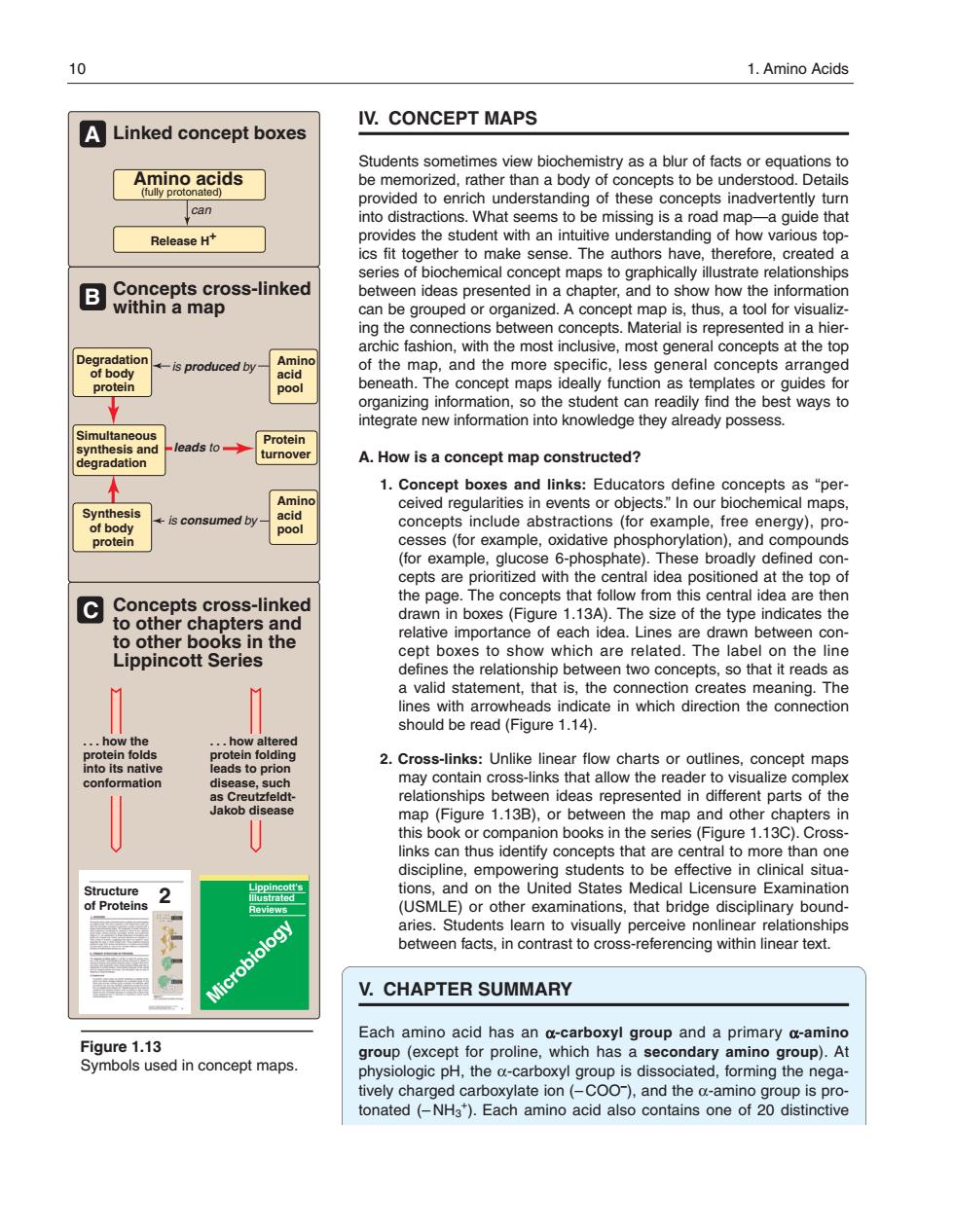正在加载图片...

10 1.Amino Acids ALinked concept boxes IV.CONCEPT MAPS Amino acids can d todrstandng of theseconadv Release H des the student with ng is a g series of biochemical concept maps to graphically illustrate relationships ninamopss-linked ideas presented in a chapter,and to show how the informatio archic fashion,with the most inclusive,most general concepts at the top is produced by- so the student t can readily find the best ways ntegrate new information into knowledge they already possess. ads to→ A.How is a concept map constructed? 1.Concept boxes and links:Educators define concepts as"per ceived regularities in events or objects."In our biochemical maps, is consumed by- concepts include abs energy),pro cepts are prioritized with the central idea positioned at the top of Concepts cross-linkec rawnohscates the to other boo in the bet Lippincott Series cept boxes to show which are related.The label on the line lationship between two concepts.tes me crea should be read (Figure 1.14). 2.Cross-links:Unlike linear flow ch relationships between ideas represented in different parts of the or en the map othe links can thus identify concepts that are central to more than one discipline,empowering students to be effective in clinical situa 2 the United States M dical petween facts.in contrast to within inear text. V.CHAPTER SUMMARY oup is dissociated.forming the nega tonated(-NHa').Each amino acid also contains one of 20 distinctive IV. CONCEPT MAPS Students sometimes view biochemistry as a blur of facts or equations to be memorized, rather than a body of concepts to be understood. Details provided to enrich understanding of these concepts inadvertently turn into distractions. What seems to be missing is a road map—a guide that provides the student with an intuitive understanding of how various topics fit together to make sense. The authors have, therefore, created a series of biochemical concept maps to graphically illustrate relationships between ideas presented in a chapter, and to show how the information can be grouped or organized. A concept map is, thus, a tool for visualizing the connections between concepts. Material is represented in a hierarchic fashion, with the most inclusive, most general concepts at the top of the map, and the more specific, less general concepts arranged beneath. The concept maps ideally function as templates or guides for organizing information, so the student can readily find the best ways to integrate new information into knowledge they already possess. A. How is a concept map constructed? 1. Concept boxes and links: Educators define concepts as “perceived regularities in events or objects.” In our biochemical maps, concepts include abstractions (for example, free energy), processes (for example, oxidative phosphorylation), and compounds (for example, glucose 6-phosphate). These broadly defined concepts are prioritized with the central idea positioned at the top of the page. The concepts that follow from this central idea are then drawn in boxes (Figure 1.13A). The size of the type indicates the relative importance of each idea. Lines are drawn between concept boxes to show which are related. The label on the line defines the relationship between two concepts, so that it reads as a valid statement, that is, the connection creates meaning. The lines with arrowheads indicate in which direction the connection should be read (Figure 1.14). 2. Cross-links: Unlike linear flow charts or outlines, concept maps may contain cross-links that allow the reader to visualize complex relationships between ideas represented in different parts of the map (Figure 1.13B), or between the map and other chapters in this book or companion books in the series (Figure 1.13C). Crosslinks can thus identify concepts that are central to more than one discipline, empowering students to be effective in clinical situations, and on the United States Medical Licensure Exam ination (USMLE) or other examinations, that bridge disciplinary boundaries. Students learn to visually perceive nonlinear relationships between facts, in contrast to cross-referencing within linear text. V. CHAPTER SUMMARY Each amino acid has an α-carboxyl group and a primary α-amino group (except for proline, which has a secondary amino group). At physiologic pH, the α-carboxyl group is dissociated, forming the negatively charged carboxylate ion (– COO– ), and the α-amino group is protonated (– NH3 +). Each amino acid also contains one of 20 distinctive 10 1. Amino Acids Figure 1.13 Symbols used in concept maps. Amino acids (fully protonated) Release H+ can A B Linked concept boxes Microbiology Lippincott's Illustrated Reviews Protein turnover Degradation of body protein Synthesis of body protein is produced by is consumed by Amino acid pool Amino acid pool leads to Concepts cross-linked within a map C Concepts cross-linked to other chapters and to other books in the Lippincott Series . . . how the protein folds into its native conformation . . . how altered protein folding leads to prion disease, such as CreutzfeldtJakob disease Simultaneous synthesis and degradation Structure of Proteins 2 168397_P001-012.qxd7.0:02 Protein structure 5-20-04 2010.4.4 9:45 AM Page 10